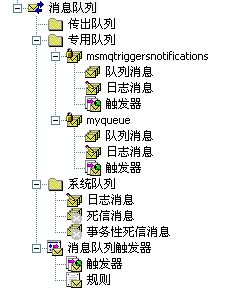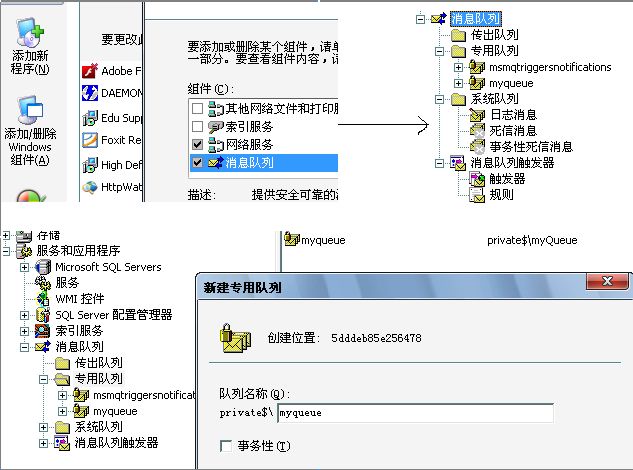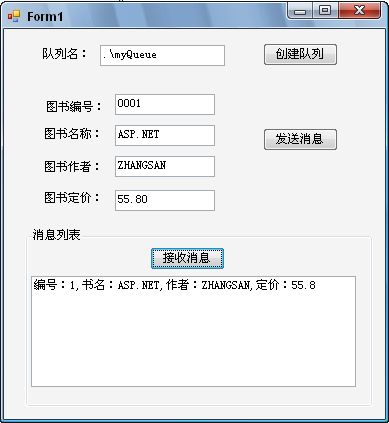|
MSMQ是微软消息队列的英文缩写。那么什么是消息队列?这些介绍网上一大片这里就不多说了。本文对于大虾级的人物来说这只是小玩意而已,对于初学者来说这文章还是有一定的帮助,希望路过的大虾们别笑话我班门弄斧。
一、MSMQ介绍和安装消息队列
关于MSMQ详细的介绍请大家向http://www.baidu.com/或http://www.g.cn/等专家咨询。
使用消息队列的优点:稳定、消息优先级、脱机能力以及安全性。
消息队列分为用户创建的队列(专用队列)和系统队列,用户队列分为,。我是Windows XP,看下图所示(myQueue为自己创建的消息队列,msmqtriggersnotifiations为通用队列):

对消息队列有了简单的了解后,使用MSMQ进行软件开发需要安装MSMQ,安装完后就该进入实际的开发阶段。具体的安装过程就是在控制面板里“添加/删除程序”下“添加/删除Windows组件”,完成添加就OK。安装完成后就可以通过交互界添加新的消息队列,详细如下图:

出了上面这种交互界面来创建MSMQ外,也可以通过编程来完成,.NET框架里的MessageQueue类下有一静态方法Create,用来完成消息队列的创建,其定义如下:
1 // //
2 // 摘要: // 摘要:
3 // 在指定的路径中创建非事务性“消息队列”队列。 // 在指定的路径中创建非事务性“消息队列”队列。
4 // //
5 // 参数: // 参数:
6 // path: // path:
7 // 要创建的队列的路径。 // 要创建的队列的路径。
8 // //
9 // 返回结果: // 返回结果:
10 // 表示新队列的 System.Messaging.MessageQueue。 // 表示新队列的 System.Messaging.MessageQueue。
11 public static MessageQueue Create(string path); public static MessageQueue Create(string path);
12 // //
13 // 摘要: // 摘要:
14 // 在指定的路径中创建事务性或非事务性“消息队列”队列。 // 在指定的路径中创建事务性或非事务性“消息队列”队列。
15 // //
16 // 参数: // 参数:
17 // transactional: // transactional:
18 // 如果创建事务性队列,为 true;如果创建非事务性队列,则为 false。 // 如果创建事务性队列,为 true;如果创建非事务性队列,则为 false。
19 // //
20 // path: // path:
21 // 要创建的队列的路径。 // 要创建的队列的路径。
22 // //
23 // 返回结果: // 返回结果:
24 // 表示新队列的 System.Messaging.MessageQueue。 // 表示新队列的 System.Messaging.MessageQueue。
25 public static MessageQueue Create(string path, bool transactional); public static MessageQueue Create(string path, bool transactional);
实现消息队列的创建简单代码(C#),创建一个名为"myQueue"的非事务性"消息队列",如下:
 MessageQueue.Create(@".\private$\myQueue"); MessageQueue.Create(@".\private$\myQueue");二、创建、删除和管理队列
在.NET环境下编写Message Queue程序的前提就是需要先安装MSMQ,本文之前已经作了详细的介绍。要开发MSMQ程序就必须学习一个很重要的类(MessageQueue),该类位于名称空间System.Messageing下。其中有几个常用的方法必须掌握:
--Create方法:创建使用指定路径的新消息队列。
--Delete方法:删除现有的消息队列。
--Existe方法:查看指定消息队列是否存在。
--GetAllMessages()方法:得到队列中的所有消息。
--GetPublicQueues方法:在“消息队列”网络中定位消息队列。
--Peek/BeginPeek方法:查看某个特定队列中的消息队列,但不从该队列中移出消息。
--Receive/BeginReceive方法:检索指定消息队列中最前面的消息并将其从该队列中移除。
--Send方法:发送消息到指定的消息队列。
--Purge方法:清空指定队列的消息。
上述列举的方法在此就不作详细介绍,大家可以通过下面的示例程序中来体会他们各自的功能。
三、发送和序列化消息
MSMQ消息队列中定义的消息由一个主体(body)和若干属性构成。消息的主体可以由文本、二进制构成,根据需要还可以被加密。在MSMQ 中消息的大小不能够超过4MB。发送消息是通过Send方法来完成的,需要一个Message参数。
1、发送消息:
步骤:连接队列-->指定消息格式-->提供要发送的数据(主体)-->调用Send()方法将消息发送出去。详细见后面的示例程序。
2、序列化消息:
消息序列化可以通过.NET Framework附带的三个预定义格式化程序来完成:
-- XMLMessageFormatter对象----MessageQueue组件的默认格式化程序设置。
-- BinaryMessageFormatter对象;
-- ActiveXMessageFormatter对象;
由于后两者格式化后的消息通常不能为人阅读,所以我们经常用到的是XMLMessageFormatter对象。该对象构造方法有三种重载:
1 public XmlMessageFormatter(); public XmlMessageFormatter();
2 public XmlMessageFormatter(string[] targetTypeNames); public XmlMessageFormatter(string[] targetTypeNames);
3 public XmlMessageFormatter(Type[] targetTypes); public XmlMessageFormatter(Type[] targetTypes);
如我们后面的示例程序中用到的序列化语句:
1 //序列化为字符串 //序列化为字符串
2  XmlMessageFormatter formatter = new XmlMessageFormatter(new Type[] XmlMessageFormatter formatter = new XmlMessageFormatter(new Type[]  { typeof(string) }); { typeof(string) });
四、读取和接收消息
1、读取消息:
也就是从指定队列中获取消息,详细请查看本文前面的关于消息操作的方法介绍。
2、接收消息有两种方式:
--> 通过Receive方法--具体功能请返回本文前面有详细介绍。
--> 通过Peek方法--具体功能请返回本文前面有详细介绍。
五、消息使用实例
通过上面一系列的介绍,了解了MessageQueue类和常用的方法后,下面我们通过一个简单的示例程序来分析消息队列的创建、发送消息以及接收消息等相关知识点:
1、通过Create方法创建使用指定路径的新消息队列
1  /**//// <summary> /**//// <summary>
2 /// 通过Create方法创建使用指定路径的新消息队列 /// 通过Create方法创建使用指定路径的新消息队列
3 /// </summary> /// </summary>
4 /// <param name="queuePath"></param> /// <param name="queuePath"></param>
5 public static void Createqueue(string queuePath) public static void Createqueue(string queuePath)
6   { {
7 try try
8   { {
9 if (!MessageQueue.Exists(queuePath)) if (!MessageQueue.Exists(queuePath))
10   { {
11 MessageQueue.Create(@".\private$\myQueue"); MessageQueue.Create(@".\private$\myQueue");
12 } }
13 else else
14   { {
15 Console.WriteLine(queuePath + "已经存在!"); Console.WriteLine(queuePath + "已经存在!");
16 } }
17 } }
18 catch (MessageQueueException e) catch (MessageQueueException e)
19   { {
20 Console.WriteLine(e.Message); Console.WriteLine(e.Message);
21 } }
22 } }
2、连接消息队列并发送消息到队列
1  /**//// <summary> /**//// <summary>
2 /// 连接消息队列并发送消息到队列 /// 连接消息队列并发送消息到队列
3 /// </summary> /// </summary>
4 public static void SendMessage() public static void SendMessage()
5   { {
6 try try
7   { {
8 //连接到本地的队列 //连接到本地的队列
9 MessageQueue myQueue = new MessageQueue(".\\private$\\myQueue"); MessageQueue myQueue = new MessageQueue(".\\private$\\myQueue");
10
11 Message myMessage = new Message(); Message myMessage = new Message();
12 myMessage.Body = "消息内容"; myMessage.Body = "消息内容";
13  myMessage.Formatter = new XmlMessageFormatter(new Type[] myMessage.Formatter = new XmlMessageFormatter(new Type[]  { typeof(string) }); { typeof(string) });
14 //发送消息到队列中 //发送消息到队列中
15 myQueue.Send(myMessage); myQueue.Send(myMessage);
16 } }
17 catch (ArgumentException e) catch (ArgumentException e)
18   { {
19 Console.WriteLine(e.Message); Console.WriteLine(e.Message);
20 } }
21 } }
3、连接消息队列并从消息队列中接收消息
1  /**//// <summary> /**//// <summary>
2 /// 连接消息队列并从队列中接收消息 /// 连接消息队列并从队列中接收消息
3 /// </summary> /// </summary>
4 public static void ReceiveMessage() public static void ReceiveMessage()
5   { {
6 //连接到本地队列 //连接到本地队列
7 MessageQueue myQueue = new MessageQueue(".\\private$\\myQueue"); MessageQueue myQueue = new MessageQueue(".\\private$\\myQueue");
8  myQueue.Formatter = new XmlMessageFormatter(new Type[] myQueue.Formatter = new XmlMessageFormatter(new Type[]  { typeof(string) }); { typeof(string) });
9 try try
10   { {
11 //从队列中接收消息 //从队列中接收消息
12 Message myMessage = myQueue.Receive(); Message myMessage = myQueue.Receive();
13 string context = (string)myMessage.Body; //获取消息的内容 string context = (string)myMessage.Body; //获取消息的内容
14 Console.WriteLine("消息内容为:" + context); Console.WriteLine("消息内容为:" + context);
15 } }
16 catch (MessageQueueException e) catch (MessageQueueException e)
17   { {
18 Console.WriteLine(e.Message); Console.WriteLine(e.Message);
19 } }
20 catch (InvalidCastException e) catch (InvalidCastException e)
21   { {
22 Console.WriteLine(e.Message); Console.WriteLine(e.Message);
23 } }
24 } }
4、连接队列并清空队列的全部消息
1  /**//// <summary> /**//// <summary>
2 /// 清空指定队列的消息 /// 清空指定队列的消息
3 /// </summary> /// </summary>
4 public static void ClearMessage() public static void ClearMessage()
5   { {
6 MessageQueue myQueue = new MessageQueue(".\\private$\\myQueue"); MessageQueue myQueue = new MessageQueue(".\\private$\\myQueue");
7 myQueue.Purge(); myQueue.Purge();
8 } }
5、连接队列并获取队列的全部消息
1  /**//// <summary> /**//// <summary>
2 /// 连接队列并获取队列的全部消息 /// 连接队列并获取队列的全部消息
3 /// </summary> /// </summary>
4 public static void GetAllMessage() public static void GetAllMessage()
5   { {
6 //连接到本地队列 //连接到本地队列
7 MessageQueue myQueue = new MessageQueue(".\\private$\\myQueue"); MessageQueue myQueue = new MessageQueue(".\\private$\\myQueue");
8 Message[] message = myQueue.GetAllMessages(); Message[] message = myQueue.GetAllMessages();
9  XmlMessageFormatter formatter = new XmlMessageFormatter(new Type[] XmlMessageFormatter formatter = new XmlMessageFormatter(new Type[]  { typeof(string) }); { typeof(string) });
10 for (int i = 0; i < message.Length; i++) for (int i = 0; i < message.Length; i++)
11   { {
12 message[i].Formatter = formatter; message[i].Formatter = formatter;
13 Console.WriteLine(message[i].Body.ToString()); Console.WriteLine(message[i].Body.ToString());
14 } }
15 } }
上面依次的列举出来5个方法,这里我就不做测试了。上述方法全部通过测试的,我在后面提供个连接,没弄清楚的朋友可下载源程序自己去运行调试下。
  本实例完整代码 本实例完整代码
1 using System; using System;
2 using System.Collections.Generic; using System.Collections.Generic;
3 using System.Text; using System.Text;
4 using System.Messaging; using System.Messaging;
5
6 namespace MSMQ namespace MSMQ
7   { {
8 class Program class Program
9   { {
10 static void Main(string[] args) static void Main(string[] args)
11   { {
12 Createqueue(".\\myQueue"); Createqueue(".\\myQueue");
13 SendMessage(); SendMessage();
14 GetAllMessage(); GetAllMessage();
15 //ReceiveMessage(); //ReceiveMessage();
16 } }
17
18
19  /**//// <summary> /**//// <summary>
20 /// 通过Create方法创建使用指定路径的新消息队列 /// 通过Create方法创建使用指定路径的新消息队列
21 /// </summary> /// </summary>
22 /// <param name="queuePath"></param> /// <param name="queuePath"></param>
23 public static void Createqueue(string queuePath) public static void Createqueue(string queuePath)
24   { {
25 try try
26   { {
27 if (!MessageQueue.Exists(queuePath)) if (!MessageQueue.Exists(queuePath))
28   { {
29 MessageQueue.Create(@".\private$\myQueue"); MessageQueue.Create(@".\private$\myQueue");
30 } }
31 else else
32   { {
33 Console.WriteLine(queuePath + "已经存在!"); Console.WriteLine(queuePath + "已经存在!");
34 } }
35 } }
36 catch (MessageQueueException e) catch (MessageQueueException e)
37   { {
38 Console.WriteLine(e.Message); Console.WriteLine(e.Message);
39 } }
40 } }
41
42  /**//// <summary> /**//// <summary>
43 /// 连接消息队列并发送消息到队列 /// 连接消息队列并发送消息到队列
44 /// </summary> /// </summary>
45 public static void SendMessage() public static void SendMessage()
46   { {
47 try try
48   { {
49 //连接到本地的队列 //连接到本地的队列
50 MessageQueue myQueue = new MessageQueue(".\\private$\\myQueue"); MessageQueue myQueue = new MessageQueue(".\\private$\\myQueue");
51
52 Message myMessage = new Message(); Message myMessage = new Message();
53 myMessage.Body = "消息内容"; myMessage.Body = "消息内容";
54  myMessage.Formatter = new XmlMessageFormatter(new Type[] myMessage.Formatter = new XmlMessageFormatter(new Type[]  { typeof(string) }); { typeof(string) });
55 //发送消息到队列中 //发送消息到队列中
56 myQueue.Send(myMessage); myQueue.Send(myMessage);
57 } }
58 catch (ArgumentException e) catch (ArgumentException e)
59   { {
60 Console.WriteLine(e.Message); Console.WriteLine(e.Message);
61 } }
62 } }
63
64  /**//// <summary> /**//// <summary>
65 /// 连接消息队列并从队列中接收消息 /// 连接消息队列并从队列中接收消息
66 /// </summary> /// </summary>
67 public static void ReceiveMessage() public static void ReceiveMessage()
68   { {
69 //连接到本地队列 //连接到本地队列
70 MessageQueue myQueue = new MessageQueue(".\\private$\\myQueue"); MessageQueue myQueue = new MessageQueue(".\\private$\\myQueue");
71  myQueue.Formatter = new XmlMessageFormatter(new Type[] myQueue.Formatter = new XmlMessageFormatter(new Type[]  { typeof(string) }); { typeof(string) });
72 try try
73   { {
74 //从队列中接收消息 //从队列中接收消息
75 Message myMessage = myQueue.Receive(); Message myMessage = myQueue.Receive();
76 string context = (string)myMessage.Body; //获取消息的内容 string context = (string)myMessage.Body; //获取消息的内容
77 Console.WriteLine("消息内容为:" + context); Console.WriteLine("消息内容为:" + context);
78 } }
79 catch (MessageQueueException e) catch (MessageQueueException e)
80   { {
81 Console.WriteLine(e.Message); Console.WriteLine(e.Message);
82 } }
83 catch (InvalidCastException e) catch (InvalidCastException e)
84   { {
85 Console.WriteLine(e.Message); Console.WriteLine(e.Message);
86 } }
87 } }
88
89  /**//// <summary> /**//// <summary>
90 /// 清空指定队列的消息 /// 清空指定队列的消息
91 /// </summary> /// </summary>
92 public static void ClearMessage() public static void ClearMessage()
93   { {
94 MessageQueue myQueue = new MessageQueue(".\\private$\\myQueue"); MessageQueue myQueue = new MessageQueue(".\\private$\\myQueue");
95 myQueue.Purge(); myQueue.Purge();
96 } }
97
98  /**//// <summary> /**//// <summary>
99 /// 连接队列并获取队列的全部消息 /// 连接队列并获取队列的全部消息
100 /// </summary> /// </summary>
101 public static void GetAllMessage() public static void GetAllMessage()
102   { {
103 //连接到本地队列 //连接到本地队列
104 MessageQueue myQueue = new MessageQueue(".\\private$\\myQueue"); MessageQueue myQueue = new MessageQueue(".\\private$\\myQueue");
105 Message[] message = myQueue.GetAllMessages(); Message[] message = myQueue.GetAllMessages();
106  XmlMessageFormatter formatter = new XmlMessageFormatter(new Type[] XmlMessageFormatter formatter = new XmlMessageFormatter(new Type[]  { typeof(string) }); { typeof(string) });
107 for (int i = 0; i < message.Length; i++) for (int i = 0; i < message.Length; i++)
108   { {
109 message[i].Formatter = formatter; message[i].Formatter = formatter;
110 Console.WriteLine(message[i].Body.ToString()); Console.WriteLine(message[i].Body.ToString());
111 } }
112 } }
113 } }
114 } }
115 六、复杂消息发送实例
通过上面一系列的介绍,对于简单消息的发送和接收及消息的管理应该都不会有什么问题了,下面我在介绍一下关于复杂的消息处理,现在有这样一个需求,要求通过消息队列将一本图书信息发送到队列里,然后从消息队列里读取出来。图书的基本信息包括图书编号、图书名称、图书作者以及图书定价,这样的一个复杂的对象类型怎么来传输呢?详细如下:
  Book对象 Book对象
1 namespace MSMQ.App namespace MSMQ.App
2   { {
3 public class Book public class Book
4   { {
5 private int _BookId; private int _BookId;
6 public int BookId public int BookId
7   { {
8  get get  { return _BookId; } { return _BookId; }
9  set set  { _BookId = value; } { _BookId = value; }
10 } }
11
12 private string _BookName; private string _BookName;
13 public string BookName public string BookName
14   { {
15  get get  { return _BookName; } { return _BookName; }
16  set set  { _BookName = value; } { _BookName = value; }
17 } }
18
19 private string _BookAuthor; private string _BookAuthor;
20 public string BookAuthor public string BookAuthor
21   { {
22  get get  { return _BookAuthor; } { return _BookAuthor; }
23  set set  { _BookAuthor = value; } { _BookAuthor = value; }
24 } }
25
26 private double _BookPrice; private double _BookPrice;
27 public double BookPrice public double BookPrice
28   { {
29  get get  { return _BookPrice; } { return _BookPrice; }
30  set set  { _BookPrice = value; } { _BookPrice = value; }
31 } }
32 } }
33 } }
1 namespace MSMQ.App namespace MSMQ.App
2   { {
3 public class MsgQueue public class MsgQueue
4   { {
5  /**//// <summary> /**//// <summary>
6 /// 通过Create方法创建使用指定路径的新消息队列 /// 通过Create方法创建使用指定路径的新消息队列
7 /// </summary> /// </summary>
8 /// <param name="queuePath"></param> /// <param name="queuePath"></param>
9 public static void Createqueue(string queuePath) public static void Createqueue(string queuePath)
10   { {
11 try try
12   { {
13 if (!MessageQueue.Exists(queuePath)) if (!MessageQueue.Exists(queuePath))
14   { {
15 MessageQueue.Create(@".\private$\myQueue"); MessageQueue.Create(@".\private$\myQueue");
16 MessageBox.Show("创建队列成功!"); MessageBox.Show("创建队列成功!");
17 } }
18 else else
19   { {
20 MessageBox.Show(queuePath + "已经存在!"); MessageBox.Show(queuePath + "已经存在!");
21 } }
22 } }
23 catch (MessageQueueException e) catch (MessageQueueException e)
24   { {
25 MessageBox.Show(e.Message); MessageBox.Show(e.Message);
26 } }
27 } }
28
29  /**//// <summary> /**//// <summary>
30 /// 连接消息队列并发送消息到队列 /// 连接消息队列并发送消息到队列
31 /// </summary> /// </summary>
32 public static bool SendMessage(Book book) public static bool SendMessage(Book book)
33   { {
34 bool flag = false; bool flag = false;
35 try try
36   { {
37 //连接到本地的队列 //连接到本地的队列
38 MessageQueue myQueue = new MessageQueue(".\\private$\\myQueue"); MessageQueue myQueue = new MessageQueue(".\\private$\\myQueue");
39
40 System.Messaging.Message myMessage = new System.Messaging.Message(); System.Messaging.Message myMessage = new System.Messaging.Message();
41 myMessage.Body = book; myMessage.Body = book;
42  myMessage.Formatter = new XmlMessageFormatter(new Type[] myMessage.Formatter = new XmlMessageFormatter(new Type[]  { typeof(MSMQ.App.Book) }); { typeof(MSMQ.App.Book) });
43 //发送消息到队列中 //发送消息到队列中
44 myQueue.Send(myMessage); myQueue.Send(myMessage);
45 flag = true; flag = true;
46 } }
47 catch (ArgumentException e) catch (ArgumentException e)
48   { {
49 MessageBox.Show(e.Message); MessageBox.Show(e.Message);
50 } }
51 return flag; return flag;
52 } }
53
54  /**//// <summary> /**//// <summary>
55 /// 连接消息队列并从队列中接收消息 /// 连接消息队列并从队列中接收消息
56 /// </summary> /// </summary>
57 public static string ReceiveMessage() public static string ReceiveMessage()
58   { {
59 //连接到本地队列 //连接到本地队列
60 MessageQueue myQueue = new MessageQueue(".\\private$\\myQueue"); MessageQueue myQueue = new MessageQueue(".\\private$\\myQueue");
61  myQueue.Formatter = new XmlMessageFormatter(new Type[] myQueue.Formatter = new XmlMessageFormatter(new Type[]  { typeof(MSMQ.App.Book) }); { typeof(MSMQ.App.Book) });
62 try try
63   { {
64 //从队列中接收消息 //从队列中接收消息
65 System.Messaging.Message myMessage = myQueue.Receive(); System.Messaging.Message myMessage = myQueue.Receive();
66 Book book = (Book)myMessage.Body; //获取消息的内容 Book book = (Book)myMessage.Body; //获取消息的内容
67 return string.Format("编号:{0},书名:{1},作者:{2},定价:{3}", return string.Format("编号:{0},书名:{1},作者:{2},定价:{3}",
68 book.BookId, book.BookId,
69 book.BookName, book.BookName,
70 book.BookAuthor, book.BookAuthor,
71 book.BookPrice); book.BookPrice);
72 } }
73 catch (MessageQueueException e) catch (MessageQueueException e)
74   { {
75 MessageBox.Show(e.Message); MessageBox.Show(e.Message);
76 } }
77 catch (InvalidCastException e) catch (InvalidCastException e)
78   { {
79 MessageBox.Show(e.Message); MessageBox.Show(e.Message);
80 } }
81 return null; return null;
82 } }
83 } }
84 } }
其实发送复杂的消息也就是在消息序列化上有些差别,别的地方与发送普通文本消息没什么大的变化,上面类里提供了创建队列,发送消息到队列,从队列获取消息三个方法,测试结果如下:

上示例中,完成了一个复杂类型的消息发送到队列及从队列中读取的演义,详细请下载代码查看:
点击这里下载本文示例代码 | 